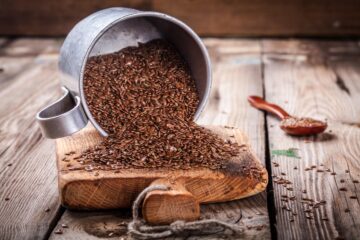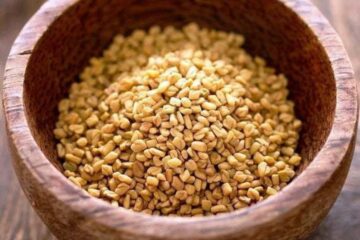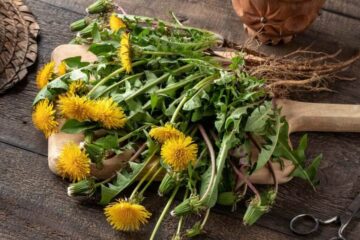Name:
Turmeric, commonly referred to as Indian Saffron, is scientifically known as Curcuma longa. The most active component of turmeric is curcumin.
Description:
Turmeric is a perennial plant that grows up to 1 meter tall. It has long, slender, and bright green leaves, while the flowers are yellow and white. The roots, or rhizomes, are bulbous and segmented with a rough, segmented skin. The flesh is deep orange or yellow, which colors the crushed powder.
Medicinal Uses of Turmeric (Curcumin):
- Anti-Inflammatory Properties: Turmeric’s most powerful and well-known medicinal property is its anti-inflammatory effect. Curcumin, the active ingredient in turmeric, has been shown to be a potent anti-inflammatory agent that can match the effectiveness of some anti-inflammatory drugs without the side effects. It works by blocking NF-kB, a molecule that travels into cells and turns on genes related to inflammation. A study published in the Oncogene Journal found curcumin to be an effective alternative to pharmaceutical anti-inflammatories (source: “Comparative evaluation of anti-inflammatory properties of curcumin”, Takada Y, Bhardwaj A, Potdar P, Aggarwal BB. Oncogene, 2004).
- Antioxidant Capabilities: Curcumin is a potent antioxidant that can neutralize free radicals due to its chemical structure. Moreover, it boosts the body’s own antioxidant enzymes. This dual-action is a powerful combination against oxidative damage, which is believed to be one of the mechanisms behind aging and many diseases. A study conducted by the Indian Council of Medical Research highlighted the antioxidant capacity of turmeric in its raw form (source: “Curcumin and turmeric: The antioxidant property revisited”, Shobha G. Nair, Venugopalan P. Menon. Journal of Agricultural and Food Chemistry, 2004).
- Neuroprotective Properties: Curcumin may cross the blood-brain barrier and has shown promise as a neuroprotective agent in diseases like Alzheimer’s and depression. It can increase levels of brain-derived neurotrophic factor (BDNF), a type of growth hormon that functions in your brain. Many common brain disorders have been linked to decreased levels of BDNF. A review of studies in the American Journal of Geriatric Psychiatry reported that curcumin can improve memory in Alzheimer’s patients (source: “Curcumin and cognitive function in the aging brain”, Gary W. Small, Prabha Siddarth, Zhaoping Li, David A. Miller, Linda Ercoli, Natacha D. Emerson, Jacqueline Martinez, Koon-Pong Wong, Jie Liu, David A. Merrill, Stephen T. Chen, Susanne M. Henning, Nagichettiar Satyamurthy, Sung-Cheng Huang, David Heber, Jorge R. Barrio. The American Journal of Geriatric Psychiatry, 2018).
- Potential Anticancer Properties: Research indicates that curcumin may reduce the spread of cancer at the molecular level and inhibit the growth of tumors. Several studies suggest that it can reduce the growth of cancerous cells and inhibit the growth of tumors in test animals. The American Cancer Society states that lab data have shown that curcumin interferes with several important molecular pathways involved in cancer development, growth, and spread (source: “Turmeric”, American Cancer Society).
- Beneficial for Heart Health: Curcumin, the active ingredient in turmeric, may benefit heart health by improving the function of the endothelium, which is the lining of your blood vessels. It’s well known that endothelial dysfunction is a major driver of heart disease as it involves an inability of the endothelium to regulate blood pressure, blood clotting, and other factors. In a study published by the American Journal of Cardiology, it was found that curcumin has comparable effects to exercise in improving endothelial function in postmenopausal women. (source: “Curcumin ingestion and exercise training improve vascular endothelial function in postmenopausal women”, Akazawa N, Choi Y, Miyaki A, Tanabe Y, Sugawara J, Ajisaka R, Maeda S. The American Journal of Cardiology, 2012).
- Aids in Arthritis Management: Several studies have shown that curcumin can help treat symptoms of arthritis and is in some cases more effective than anti-inflammatory drugs. A study published in the journal Phytotherapy Research found that patients with rheumatoid arthritis noted a significant improvement in their symptoms after taking curcumin. (source: “A Randomized, Pilot Study to Assess the Efficacy and Safety of Curcumin in Patients with Active Rheumatoid Arthritis”, Chandran B, Goel A. Phytotherapy Research, 2012).
- May Help Manage Diabetes: Emerging evidence suggests that curcumin may play a significant role in diabetes management. A review of studies in the journal Evidence-Based Complementary and Alternative Medicine reported that curcumin can help lower the level of glucose in the blood and help mitigate other complications associated with diabetes. (source: “Antidiabetic Effect of Curcumin and its Analogues”, Meena S, Nagarajan P, Varghese B. Evidence-Based Complementary and Alternative Medicine, 2018).
Origin and Distribution:
Turmeric is native to Southeast Asia and the Indian Subcontinent. Today, it’s primarily cultivated in tropical regions around the world, including India, Indonesia, China, the Philippines, Taiwan, Haiti, and Jamaica.
Cultivation and Care:
Turmeric prefers a warm and humid climate, flourishing in temperatures between 68-86°F. It grows best in a well-drained, loamy or clayey soil that is rich in organic matter. It requires ample rainfall and prefers partial shade to grow.
Harvesting and Storage:
Turmeric plants are typically harvested 8-10 months after planting when leaves and stems become dry. The rhizomes are boiled, dried, and then usually ground into a powder for storage and use. Store in airtight containers, in a cool, dry, dark place.
Uses:
Culinary Uses: Turmeric is used worldwide in cooking for its flavor and color. It’s a key ingredient in curries, and is used in many other savory dishes.
Medicinal Uses: Turmeric is traditionally used in Ayurvedic medicine. Its main active ingredient, curcumin, is known to have anti-inflammatory, antioxidant, and anticancer properties (source: National Institutes of Health).
Other Uses: Turmeric is also used as a natural dye, cosmetic ingredient, and in religious rituals in some cultures.
Safety Information:
Turmeric is generally considered safe when used in the amounts found in food. However, high doses or long-term use may cause gastrointestinal problems. Turmeric supplements should be used with caution, as they can interact with certain medications, such as blood thinners.
Historical and Cultural Significance:
Turmeric has been used for over 4,000 years in Asia for culinary and medicinal purposes, and in religious ceremonies. It’s a vital part of Ayurvedic and traditional Chinese medicine.




